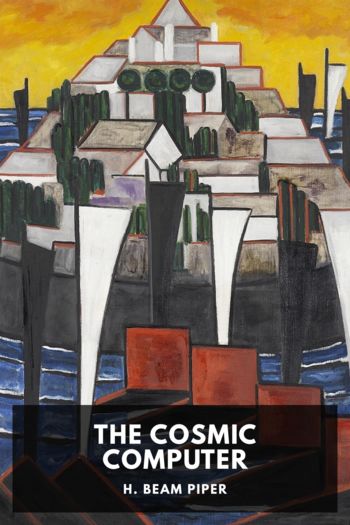The Cosmic Computer by H. Beam Piper (easy novels to read TXT) 📕

- Author: H. Beam Piper
Book online «The Cosmic Computer by H. Beam Piper (easy novels to read TXT) 📕». Author H. Beam Piper
“Better come back as soon as possible. Just explore Port Carpenter, find out what’s going to be needed to finish the ship and what facilities you have to produce it, and get things cleaned up a little so that you can start work as soon as you have people to do it. I’m organizing another company—don’t laugh, now; I’ve only started promotioneering—which I think we will call Trisystem & Interstellar Spacelines. Get me all the views you can of the ship herself and of the steel mills and that sort of thing that will produce material for finishing her; I want to use them in promotion. By the way, has she a name?”
“Only a shipyard construction number.”
“Then suppose you call her Ouroboros, after Genji Gartner’s old ship, the one that discovered the Trisystem.”
“Ouroboros II; that’s fine. Will do.”
“Good. I’ll have Sterber, Flynn & Chen-Wong make application for a charter right away. We’ll have to make Alpha-Interplanetary one of the stockholding companies, and also Koschchei Exploitation & Development, and, of course, Litchfield Exploration & Salvage …”
It was a pity there really wasn’t a Merlin. If this kept on nothing else would be able to figure out who owned how much stock in what.
They found the on-the-job engineering office for the ship in a small dome half a mile from the construction dock. Yves Jacquemont and Mack Vibart and Schalk Retief moved in and buried themselves to the ears in specifications and blueprints. The others formed into parties of three or four, and began looking about production facilities for material. There was a steel mill a mile from the construction site; it was almost fully robotic. Iron ore went in at one end, and finished sheet steel and girders and deck plates came out at the other, and a dozen men could handle the whole thing. There was a collapsium plant; there were machine-shops and forging-shops. Every time they finished inspecting one, Yves Jacquemont would have a list of half a dozen more plants that he wanted found and examined yesterday morning at the latest.
Some of them were in a frightful mess; work had been suspended and everybody had gone away leaving everything as it was. Some were in perfect order, ready to go into operation again as soon as power was put on. It had depended, apparently, upon the personal character of whoever had been in charge in the end. The nuclear-electric power unit plant was in the latter class. The man in charge of it evidently hadn’t believed in leaving messes behind, even if he didn’t expect to come back.
It was built in the shape of a T. One side of the cross-stroke contained the cartridge-case plant, where presses formed sheet-steel cylinders, some as small as a round of pistol ammunition and some the size of ten-gallon kegs. They moved toward the center on a production line, finally reaching a matter-collapser where they were plated with collapsium. From the other side, radioactive isotopes, mostly reactor-waste, came in through evacuated and collapsium-shielded chambers, were sorted, and finally, where the cross-arm of the T joined the downstroke, packed in the collapsium cases. The production line continued at right angles down the long building in which the apparatus which converted nuclear energy to electric current was assembled and packed; at the end, the finished power cartridges came off, big ones for heavy machines and tiny ones for things like hand tools and pocket lighters and razors. There were stacks of them, in all sizes, loaded on skids and ready to move out. Except for the minute and unavoidable leakage of current, they were as good as the day they were assembled, and would be for another century.
Like almost everything else, the power-cartridge plant was airtight and had its own oxygen-generator. The air-analyzer reported the oxygen insufficient to support life. That was understandable; there were a lot of furnaces which had evidently been hot when the power was cut off; they had burned up the oxygen before cooling. They put on their oxygen equipment when they got out of the car.
“I’ll go back and have a look at the power plant,” Matsui said. “If it’s like the rest of this place, it’ll be ready to go as soon as the reactors are started. I wish everybody here had left things like this.”
“Well, we’ll have to check everything to make sure nothing was left on when the main power was cut,” Conn said. “Don’t do anything back there till we give you the go-ahead.”
Matsui nodded and set off on foot along the broad aisle in the middle. Conn looked around in the dim light that filtered through the dusty glass overhead. On either side of the central aisle were two production lines; between each pair, at intervals, stood massive machines which evidently fabricated parts for the power cartridges. Over them, and over the machines directly involved in production, were receptor aerials, all oriented toward a stubby tower, twenty feet thick and fifty in height, topped by a hemispherical dome.
“That’ll be the control tower for all the machinery in here,” he decided. “Anse, suppose you and I go take a look at it.”
“We’ll take a look at the machines,” Rivas said. “Clyde, you and I can work back on the right and then come down on the other side. You know anything about this stuff?”
“Me? Nifflheim, no,” Nichols said. “I know a robo-control when I see one, and I know whether it’s set to receive or not.”
There was a self-powered lift inside the control tower. Conn and Anse rode it to the top and got out, Anse snapping on his flashlight. It was dark in the dome at the top; instead of windows there were viewscreens all around it. Five men had worked here; at least, there were four chairs at four intricate control panels, one for each of the four production lines, and a fifth chair in front of a number of communication screens. There was a heavy-duty power unit, turned off. Conn





Comments (0)